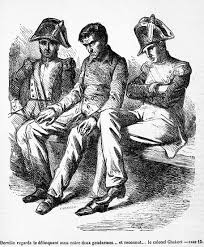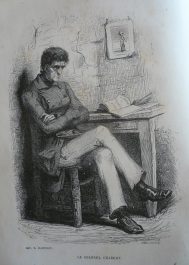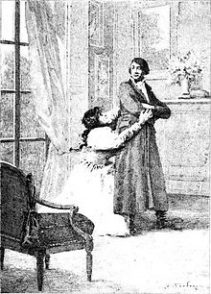
Colonel Chabert
THE HUMAN COMEDY – Honoré de Balzac We find this novel in the tenth volume of works of Honoré de Balzac edited by widow André Houssiaux, publisher Hebert & Co, successors, 7 rue Perronet – Paris (1877), classified in this edition of the time under scenes of Parisian life. By naming Scenes of Parisian life a number of the short stories that had previously appeared under the heading Scenes of Private life, Balzac shows here one of the transfer models he used in his working methods.
Scenes from private life

Colonel Chabert
COLONEL CHABERT – Scenes from private life
DEDICATION A MADAME THE COUNTESS IDA DE BOCARME, NEE DU CHASTELER.
Analysis of the work Le Colonel Chabert, which appeared in 1832, and L’Interdiction, published in early 1835, are twin works that contain the same teachings as Le Père Goriot. The decor, the proportions, the subject matter – everything seems different. And yet, we’re basically saying the same thing, showing everything that the pomp and glamour of worldly life crushes and tramples underfoot: the stars, whose dazzling brilliance, are all more or less replicas of Father Goriot’s daughters. This short story was published in the elegant magazine L’Artiste in early 1832 under the title La Transaction. The title is not unimportant. It refers to an old idea of Balzac’s, already expressed in the novels he wrote in his youth under various pseudonyms, and which is one of the most novel ideas in his dramatic system. The dramas of modern life, he thought, are no longer the passionate tragedies of novels, resolved by poison, murder or suicide; they are the muted, patient struggles within families, manifested in legal battles whose gain or loss decides the fate of a couple or a family: a marriage contract, a prohibition suit, a guardianship can enrich or deprive; a patrimony, a rank, an entire existence often depend on their outcome. This is the first discovery. The title, La Transaction , says it all. But there’s a second, interviewed at the same time. It’s possible to trick and cheat in these legal battles. Fortunes can be diverted, lives can be shattered and mortally wounded by a few of these clever maneuvers. So, quite often in social life, “hidden crimes” are committed without violence, under the authority of the law. Colonel Chabert is the story of one such crime. All the action is driven by a single, excruciating maneuver. Countess Ferraud has recognized her husband, though she denies it. The solicitor knows this, knows the risks she runs, and proposes a secret deal: Chabert will give up his lawsuit, will not claim his name, but he must be given the means to build a new life under another name: it will be very expensive. The Countess wants neither the trial nor the settlement. She wants Chabert to give up without compensation. She’s counting on her charm: she’s still young, she’s attractive, she’s skilful. She kidnaps Chabert and takes him to her country house. For a few days, she plays the comedy of tenderness, trust and abandonment. She manages to give him the illusion, without saying anything, that she still loves him, she will do what he decides, she will abandon, if he demands it, her husband, her children, she relies on his generosity. It was the right word. Chabert is moved, he doesn’t want to ruin the happiness placed in his hands. Out of the goodness of his heart, he’s ready to step aside. Chance decides everything. The colonel overhears a cynical conversation between the countess and her businessman. On learning that he was hesitating, the Countess decided: “We’ll have to end up putting him in Charenton.” This atrocious word, the revelation of this perfidy, is too much for Chabert. Complete disgust, disgust with life, disgust with men, took away his desire to fight, even his desire for revenge. He shouts his contempt to his wife. And he returns to his anonymity and misery. He becomes a beggar again because he no longer wants to live.  The solicitor takes charge of drawing the conclusion from this anecdote. His professional experience has taught him a lot. Recounting the story of Chabert, who became a resident of the Bicêtre hospice, he sees his fate as “one of those crimes against which justice is powerless”. But he’s not indignant. He’s seen too much. His profession has stripped him of all his illusions about men, and he knows them well. As Alain notes in his study of Balzac, this indifference is akin to Vautrin’s cynicism in his speech to Rastignac under the bower of the Pension Vauquer at the start of Père Goriot. Alain could have made another connection. This is almost word for word what Balzac had said ten years earlier to a priest, the Abbé de Mondivers, in his novel Argow le Pirate, which he had published under the name Horace de Saint-Aubin. In the original edition, the text of Balzac’s short story was significantly different from the one we read today. The title itself, La Transaction, and its later replacement, La Comtesse à deux mari (The Countess with Two Husbands), were designed to appeal to the reader’s sensibilities in a different way. In the transaction he proposed to his wife, the colonel demanded that her conjugal rights be recognized twice a month. This extravagant claim gave a whole new meaning to the wife’s resistance. Balzac realized this quite quickly. Three years later, he executed this first version in two lines: “I found it detestable,” he wrote to Madame Hanska, “lacking in taste, and I had the courage to start again in press.” It took him twenty days to redo his story, to which he gave a completely different meaning. We don’t know the origin of the adventure Balzac recounts. Between 1829 and 1831, he had frequented a group of former Empire officers who met at the Ecole Militaire de Saint-Cyr with his friends Carraud. Balzac used their stories in many of the tales he wrote during this period. The Viscount de Lovenjoul, a famous collector who had acquired most of Balzac’s manuscripts and papers, believed that the story of Colonel Chabert had the same origin. The same moral is found in Le Colonel Chabert , published in 1832. Here again, we find the vanities and interests engendered by the pomp and glamour of worldly life, which crush and trample all human values.
The solicitor takes charge of drawing the conclusion from this anecdote. His professional experience has taught him a lot. Recounting the story of Chabert, who became a resident of the Bicêtre hospice, he sees his fate as “one of those crimes against which justice is powerless”. But he’s not indignant. He’s seen too much. His profession has stripped him of all his illusions about men, and he knows them well. As Alain notes in his study of Balzac, this indifference is akin to Vautrin’s cynicism in his speech to Rastignac under the bower of the Pension Vauquer at the start of Père Goriot. Alain could have made another connection. This is almost word for word what Balzac had said ten years earlier to a priest, the Abbé de Mondivers, in his novel Argow le Pirate, which he had published under the name Horace de Saint-Aubin. In the original edition, the text of Balzac’s short story was significantly different from the one we read today. The title itself, La Transaction, and its later replacement, La Comtesse à deux mari (The Countess with Two Husbands), were designed to appeal to the reader’s sensibilities in a different way. In the transaction he proposed to his wife, the colonel demanded that her conjugal rights be recognized twice a month. This extravagant claim gave a whole new meaning to the wife’s resistance. Balzac realized this quite quickly. Three years later, he executed this first version in two lines: “I found it detestable,” he wrote to Madame Hanska, “lacking in taste, and I had the courage to start again in press.” It took him twenty days to redo his story, to which he gave a completely different meaning. We don’t know the origin of the adventure Balzac recounts. Between 1829 and 1831, he had frequented a group of former Empire officers who met at the Ecole Militaire de Saint-Cyr with his friends Carraud. Balzac used their stories in many of the tales he wrote during this period. The Viscount de Lovenjoul, a famous collector who had acquired most of Balzac’s manuscripts and papers, believed that the story of Colonel Chabert had the same origin. The same moral is found in Le Colonel Chabert , published in 1832. Here again, we find the vanities and interests engendered by the pomp and glamour of worldly life, which crush and trample all human values.
The Story Like Le Père Goriot , Colonel Chabert is a sinister story. At the head of his regiment, Chabert led the famous Eylau charge that decided the French victory. Seriously wounded, he is left among the dead. The official communiqué proclaimed him dead and made him a national hero. His widow, Rosalie, showered with favors by the Emperor, remarried the 27-year-old Count Ferraud, who had a great future ahead of him. Under the Restoration, it maintained its position. She’s a rich and admired woman. The dying Chabert managed to escape from the mass grave into which he had been thrown. Shattered skull, taken in by charity, beggar, locked up for insanity, it took him six years to return to France. By the time he gets there, this man, as famous and glorious as Guynemer, is an unrecognizable wreck. His frightened wife refuses to recognize him. He wants his name, his rank, his fortune and his wife back. With the help of an honest lawyer, Maître Derville, he plans to sue to have his death certificate annulled. His wife’s situation is dramatic. A trial means scandal, the loss of one’s social standing. An accommodation is ruinous. Using a clever maneuver to speculate on their tenderness, Rosalie manages to ensnare him and “morally and emotionally kill” this kind-hearted, tender-souled man by keeping him nameless and wandering. Colonel Chabert ended his life in a hospice.  A little anecdote: In 1799, before his marriage, Colonel Chabert made a will bequeathing a quarter of his estate to the hospices. Believed dead, this quarter was bequeathed to the hospices. Work written in : Paris, February-March 1832
A little anecdote: In 1799, before his marriage, Colonel Chabert made a will bequeathing a quarter of his estate to the hospices. Believed dead, this quarter was bequeathed to the hospices. Work written in : Paris, February-March 1832
The characters Chabert: (Hyacinthe dit) colonel and count. Marries Rose Chapotel who, believing herself a widow, marries Ferraud and has two children. Ferraud: (Count) emigrated then State Councillor. Wife Rose Chapotel, widow Chabert, from whom two children, one of whom is named Jules. Derville: solicitor, born in 1794. Marries Fanny Malvaut, father of daughter Mathilde, who marries Augustin Bongrand. Delbec: Businessman, then magistrate. At the time of Colonel Chabert’s story, he was the Ferraud family’s solicitor. He’s a shrewd man who knows all the tricks of the trade (bought and protected by the Ferraud couple).
1) Source analysis/history: Preface to Volume VI, compiled from the complete works of the Comédie Humaine published by France Loisirs 1985 under the auspices of the Société des Amis d’Honoré de Balzac.
2) Some of the statements made in “La géologie des personnages” are taken from Félicien Marceau’s “Balzac et son monde” (Gallimard).
No Comments